Exploring the Dynamics Behind Ocean Waves
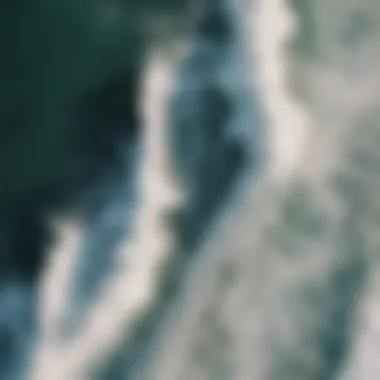
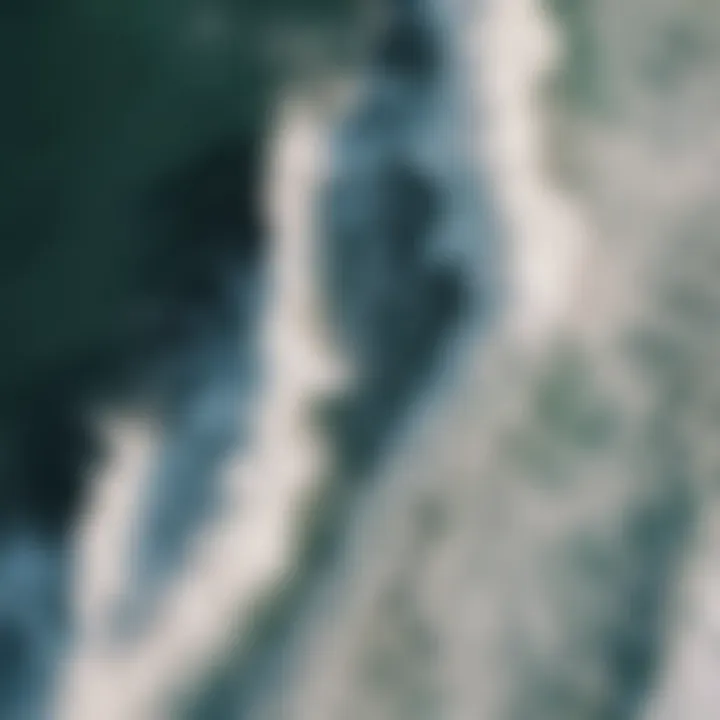
Intro
Waves on the ocean surface are not just a beautiful sight; they are a fascinating interplay of various forces. Understanding why and how these waves form can deepen our appreciation for the vast expanse of water, whether you’re lounging on the beach or tackling a rugged surf. The study of ocean waves encompasses a spectrum of topics, from the impact of wind to the role of celestial movements.
As outdoor lovers and water enthusiasts, having a grasp on what causes waves can significantly enhance your recreational experiences, be it swimming, surfing, or sailing. This article unfolds the intricate tapestry of wave formation, highlighting the essentials every athlete or adventurer should know. We’ll delve into the mechanics behind wave creation, discuss the equipment that enhances your interaction with these natural wonders, and provide techniques to maximize your safety and enjoyment in the water.
The domain of wave formation extends beyond the mere physical aspects; it includes how human activities alter natural rhythms, offering both challenges and opportunities. As we navigate through the science and reality of ocean waves, prepare to gain insights that will inspire a deeper respect for the ocean's dynamic patterns.
Gear Recommendations
Essential Gear for Beginners
For those starting their adventure, it’s vital to have the right gear to make the experience enjoyable and safe. Key items include:
- Life Jacket: Never underestimate the importance of a buoyancy aid. A bright-colored life jacket helps ensure visibility.
- Surfboard: Choose a board that suits your ability level. Soft-top boards are usually more forgiving for newbies.
- Wetsuit: Depending on the season and location, wetsuits offer warmth and protection.
- Sunscreen: Protecting your skin from UV rays is crucial, no matter the activity.
- Waterproof Bag: Keeps your belongings safe and dry while you enjoy the waves.
Advanced Equipment for Professionals
For seasoned watersport enthusiasts, the right advanced gear can make a world of difference. Here are some recommendations:
- High-Performance Surfboard: Tailored for specific wave conditions, such as shortboards for steep waves.
- Technical Wetsuit: Offers flexibility and insulation while being sleek.
- Personal Flotation Device (PFD): Specialized PFDs designed for specific sports ensure safety without hindering performance.
- GPS Device or a Smart Watch: For tracking distance and performance metrics.
- High-Quality Leash: A durable leash keeps your board close after a wipeout; trust me, it's worth the investment.
"The ocean's waves are nature’s way of reminding us of its unyielding power and beauty, combining forces in a dance of energy."
Techniques and Tips
Skill Improvement Strategies
Learning the nuances of riding the waves can enhance both your safety and enjoyment. Consider the following:
- Take Lessons: Professional instruction can fast-track your skills. They'll teach you the ropes – both figuratively and literally.
- Watch and Learn: Observing experienced surfers can help you grasp the techniques of balance, timing, and positioning.
- Practice: Spend time in the water, honing both your paddling and riding abilities. Consistency breeds improvement.
Safety Practices and Guidelines
Safety should always take precedence when enjoying ocean activities:
- Know the Conditions: Always check the surf report and tide times; conditions can change rapidly.
- Stay In Groups: Surfing or swimming with friends is both more enjoyable and safer.
- Respect the Ocean: Be mindful of your environment, keep an eye out for riptides, and adhere to local guidelines.
- Learn CPR: A useful skill that may save lives when things go wrong.
In summary, understanding what causes ocean waves provides a crucial foundation for everyone who wishes to enjoy the ocean's embrace. From the novice to the expert, knowing the ins and outs of wave formation directly impacts your experience, equipping you with knowledge that can make all the difference during your aquatic adventures.
Overview of Ocean Waves
Understanding oceans is akin to unraveling the mysteries of our planet. When we talk about ocean waves, we're not just referring to the visible undulations on the water's surface. These waves are dynamic forces shaped by a myriad of factors such as wind, geological characteristics, and human actions. Each wave carries its own story, influencing marine life, coastal ecosystems, and the activities of those who enjoy the sea.
Diving deeper into this topic unveils the intricate dance between nature and human interaction. It’s essential for enthusiasts, whether surfers, sailors, or environmentalists, to grasp the fundamentals of wave formation. Knowledge about ocean waves isn’t merely academic; it has practical implications for safety, sustainability, and the enhancement of recreational activities in aquatic environments.
In this section, we lay the groundwork. We introduce the types of waves, their anatomy, and the relevance these aspects carry in our lives—from the thrill of riding a perfect wave to the challenges posed by powerful storms. By grasping these concepts, readers gain a clearer insight into the complexities of ocean phenomena, enabling them to interact more responsibly and appreciatively with our vast waters.
"Understanding the ocean’s waves is like holding a conversation with nature, where every ripple tells a tale."
Our exploration of ocean waves embarks on an intricate path, one that covers definitions and classifications. We will also discuss how the physical properties of waves, such as their height and wavelength, affect both their impact and usability for various ocean activities.
The Role of Wind
Wind plays a pivotal role in the formation and behavior of ocean waves. It’s the primary force behind wave creation, and its characteristics significantly influence the resulting wave patterns. Understanding how wind operates in this context delves into the symbiotic relationship between atmospheric conditions and marine dynamics. This section sheds light on two main areas: how wind speed affects wave energy and size, and how wind direction influences wave formation through fetch.
Wind Speed Effects
Generating Energy in Waves
Generating energy in waves is essential for the study of ocean dynamics. Waves are not just random ripples; they’re fueled by wind that transfers energy from the atmosphere to the water surface. As wind blows across the ocean, it drags on the water, causing energy transfer that results in wave formation. This process highlights a key characteristic: energy generation in waves is highly dependent on wind speed. Higher wind speeds produce larger waves, hence more energy is transferred.
A beneficial highlight of this energy generation is its connection to renewable energy. Notably, wind energy harnessed through wave technology leverages these waves to produce electricity, thereby promoting sustainability. However, one must recognize the unique feature of varying wind speeds: too much wind can lead to chaotic, dangerous sea conditions, which isn’t advantageous for surfers or sailors alike.
Influence on Wave Size
The influence of wind speed on wave size cannot be overstated. Generally, as wind speed increases, wave height also tends to rise. This relationship can significantly affect water activities and ecosystems. For instance, moderate winds create ideal conditions for surfers, resulting in exciting, rideable waves. Conversely, very strong winds can create excessively large waves that are not just challenging but perilous, illustrating how wave size impacts both safety and enjoyment on the water.
Moreover, the key characteristic of wave influence emphasizes how intricately size dictates the dynamics between waves and submerged objects, from corals to kelp forests. This layered complexity demonstrates the advantage of understanding those wave sizes, as it aids in developing better forecasting models for various water activities.
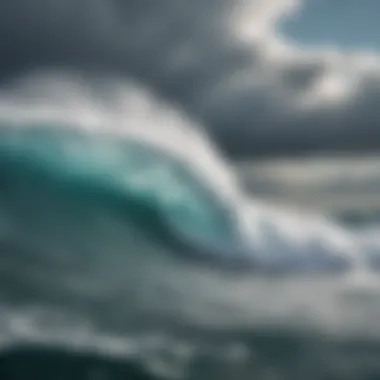
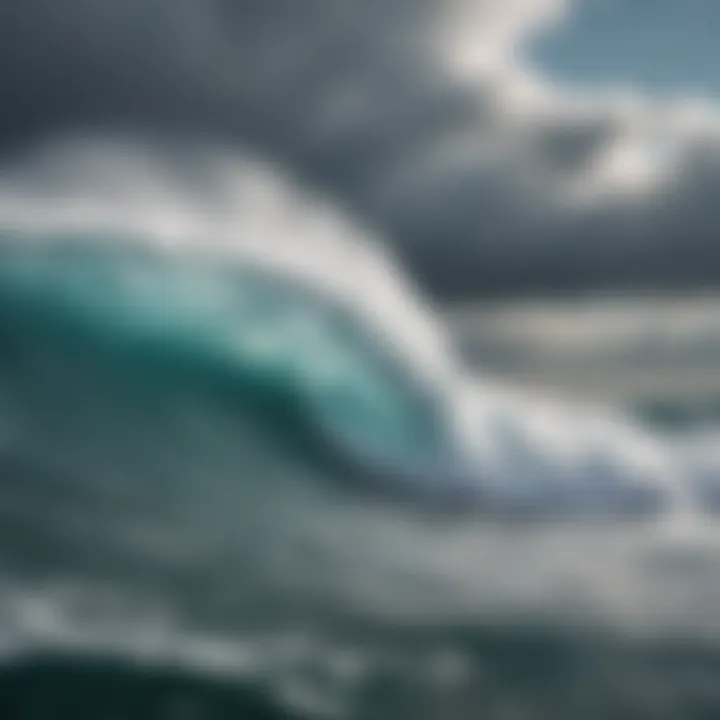
Wind Direction Impacts
Fetch Length and Wave Formation
Fetch describes the uninterrupted distance over the water that wind generates waves. When discussing wave formation, the length of the fetch holds tremendous significance. A longer fetch can lead to the development of larger waves as greater wind stress acts on the water surface over a more extended area. Notably, waves generated from a long fetch can travel vast distances, maintaining momentum and energy far from their point of origin.
This feature makes fetch a beneficial consideration for understanding coastal wave patterns. In recreational settings like surfing, knowledge of the fetch helps athletes choose optimal times to ride the waves. However, the disadvantage of short fetches shows that waves often appear choppy and weak, less suitable for quality water activities, which can lead to disappointment among enthusiasts.
Local vs. Distant Wind Impact
The impact of wind can vary significantly based on its locality. Local winds, which are those occurring directly above the water in the vicinity, tend to create waves that are more irregular and choppy. This local effect can lead to conditions that are frustrating for sailors or surfers eager for smooth rides.
On the other hand, distant winds can generate waves that are more uniform and well-shaped despite the distance traveled. The key characteristic here emphasizes the potential advantage of distant weather systems influencing surf conditions. For those interested in watersports, understanding this distinction can assist in planning adventures based on weather forecasts.
"Wind conditions can often dictate whether a day on the water becomes a thrilling adventure or a disappointing excursion."
Geological Influences
Geological influences play a significant role in understanding ocean wave formation. The characteristics of the ocean floor and coastal features fundamentally affect how waves are created, shaped, and behave. By studying geological factors, we can unravel some of the complexities behind wave dynamics, allowing us to anticipate wave patterns better, which is essential for activities such as surfing, sailing, or any oceanic endeavors.
One of the main considerations is how variations in the ocean's topography and coastal configurations lead to different wave behaviors. Every jagged edge, every slope in the seabed has the potential to alter wave energy, speed, and direction. This is vital information for those who work or play in the ocean, as knowing how geological formations can impact wave conditions is essential for safety and enjoyment in water activities.
Ocean Floor Topography
Continental Shelves
Continental shelves are shallow areas of the ocean floor that extend from a coast and are crucial in wave formation. These shelves can greatly influence wave height and energy, especially under certain weather conditions. The gradual slope of these shelves allows waves to build up energy before they reach the shore. This characteristic makes them an integral component in understanding how waves travel and transform.
A key feature of continental shelves is their shallow depth, which can often reach depths of just a few meters. This level of depth means that even average winds can generate meaningfully sized waves due to the extended duration of wind interaction over a larger area. The advantage of knowing about continental shelves lies in their predictability and consistency; surfers and marine researchers can rely on these formations to forecast wave activity.
However, the downside is that these shelves can also experience sediment erosion, which changes their shape over time and thus affects wave formation unpredictably. It's a reminder that the ocean's less stable geological features can pose challenges for those relying on steady conditions for sports or fishing.
Underwater Structures
Underwater structures, whether they are natural or man-made, have a profound effect on ocean wave behavior. Rocks, reefs, and artificial barriers, all contribute to unique wave patterns, creating areas of surf that are beloved by many water sports enthusiasts. The interaction between waves and these underwater structures often increases wave height, leading to exhilarating surf conditions.
A notable characteristic of underwater structures is their role in breaking waves. When water interacts with a reef, for example, it slows down and rises, producing waves that can be far more exciting for surfers than those in deeper water. The advantage here is clear: many surfing and swimming spots are defined by the presence of such structures, making them prime locations for aquatic activities.
On the flip side, these structures can also lead to dangerous conditions. Waves that peak suddenly due to the abruptness of the submerged structure can result in hazardous situations for inexperienced swimmers or surfers. Therefore, while underwater structures can enhance the enjoyment of watersports, they also necessitate a depth of understanding and caution.
Coastal Features
Harbors and Bays
Harbors and bays serve as natural indentations of the coastline that can significantly affect wave action. These features often act as protective barriers where waves diminish in intensity, creating calm waters ideal for sailing and other activities. The key characteristic of harbors is their ability to reduce wave forces, thus providing a safe haven for boats and watercraft.
Their natural shape tends to shelter vessels from harsh oceanic waves, making them popular choices for mooring. This feature makes harbors extremely beneficial for maritime activities, ensuring safe docking and smoother navigation. However, it is also worth noting that in times of stormy weather, swells entering these areas can create confusing wave patterns that may catch sailors off guard.
Cliffs and Beaches
Cliffs and beaches represent the dynamic interaction between land and sea, which influences wave climate and ecology profoundly. These features serve different roles; beaches absorb wave energy, while cliffs can deflect it. The main attribute of cliffs lies in their steep incline which can lead to powerful waves crashing against them, a sight that certainly adds a dramatic flair to the shoreline.
Beaches, on the other hand, exhibit the fascinating behavior of acting as buffers, dissipating wave energy and protecting inland environments. One significant advantage of beaches is their role in creating gentler wave conditions, which are particularly favorable for swimming and sunbathing. However, this balance can be disrupted by rising sea levels or intense storms that erode the coastline and alter wave dynamics, potentially impacting marine life and human activities.
Influence of Celestial Bodies
The celestial bodies have a pivotal role in shaping ocean waves that go beyond mere aesthetic value; their influence is deeply woven into the fabric of oceanic phenomena. This section explores how the gravitational pull of these celestial objects, particularly the Moon and the Sun, orchestrate the tides and, in turn, the formation of waves. Understanding these effects is not only crucial for oceanographers but also holds significance for surfers, sailors, and marine enthusiasts who rely on tidal behaviors for their activities.
The importance of celestial influence lies mainly in their ability to create predictable patterns in wave behavior, impacting everything from local fishing practices to major shipping routes. By shedding light on tidal dynamics and lunar cycles, this section aims to furnish the reader with a comprehensive understanding of oceans as an interplay between celestial mechanics and earthly actions.
Tide Dynamics
Gravitational Forces
Gravitational forces are the unseen puppeteers behind the dance of ocean waters. When one considers how the Moon’s gravity affects Earth, it becomes clearer how this relationship is vital to wave formation. The gravitational pull creates bulges in the ocean, which, as many might note, leads to high tides in those affected areas.
A key characteristic of these gravitational forces is their periodicity. They operate in a rhythmic cycle that directly aligns with the lunar phases. This predictability makes it a beneficial aspect for anyone needing to anticipate ocean behavior for various activities, such as fishing, surfing, or sailing.
One unique feature of gravitational forces is how they vary depending on location. Coastal areas experience different tidal effects based on depth, the contour of the sea floor, and surrounding landforms. This variability can be either an advantage or a disadvantage, depending on the context. For instance, some regions may enjoy significantly higher tides suitable for specific water sports, while others may be less favorable for recreational activities.
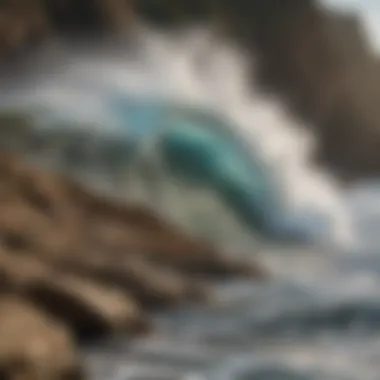
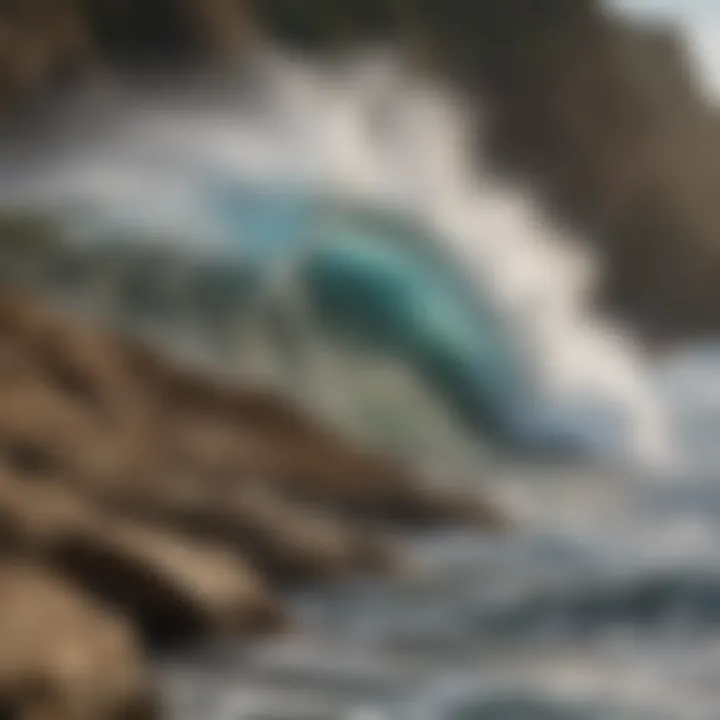
Tidal Patterns and Waves
Tidal patterns form the very backbone upon which many ocean waves ride. They serve as a predictable framework that outlines the timing and strength of wave generation. This feature is especially significant for recreational activities, as savvy wave riders can time their ventures to catch the best swells.
The key characteristic of tidal patterns is their dependence on both lunar and solar alignments. Tides are relatively easy to forecast, making them an essential component of maritime navigation and aquatic pursuits. Understanding these cycles can be invaluable for water sports enthusiasts, allowing them to optimize their experiences.
That said, the unique aspect of tidal patterns is the variance in wave energy; not all tides produce waves of equal force. Certain conditions amplify tidal movements, leading to more significant waves. This can be advantageous for surfers or sailors seeking powerful conditions, but can also pose risks if the unexpected surge catches them off-guard.
Lunar Cycle Effects
Spring and Neap Tides
Spring and neap tides are two outcomes of the Moon's gravitational pull combined with the Sun's influence. During spring tides, the Earth, Moon, and Sun align, causing higher high tides and lower low tides. This amplifies the overall energy in the water, contributing to larger waves.
The key characteristic instilled by spring tides is immense energy, ideal for watersport enthusiasts looking for thrilling conditions. Given this distinctive feature, athletes actively plan their activities around these tides to capitalize on the surging energy of the waves, making it a popular section of discussion in the surfing community.
However, spring tides come with their challenges as well. The larger waves can prove dangerous for those who are either inexperienced or unaware of the increased risks. Therefore, knowledge of these cycles is crucial.
Impact on Wave Activity
The impact on wave activity during different lunar phases can’t be overstated. The interplay between tidal forces and wind conditions can either amplify or diminish wave height and energy. For instance, during a full moon, the combination of spring tides and strong winds can lead to particularly rough sea conditions, influencing water sports such as kitesurfing and sailing.
The key takeaway from observing this impact is to recognize the nuances. Understanding wave activity in tune with lunar phases allows enthusiasts to tailor their plans accordingly, maximizing their thrill while remaining safe.
Nevertheless, the fluctuation in conditions can be both an opportunity and a challenge. The unpredictability that comes with lunar cycles in stormy weather can make or break experiences for water sports aficionados. Managing these factors is vital for anyone who seeks to dance along the waves.
Climate and Weather Patterns
Understanding climate and weather patterns is crucial for comprehending the formation of ocean waves. These elements play a significant role in how waves develop, affect their strength, and influence their behavior. When we talk about climate, we refer to the long-term trends—like temperatures, precipitation, and wind patterns—that shape marine environments over time. Weather patterns, on the other hand, deal with short-term atmospheric conditions, such as storms and temperature fluctuations.
Impact of Storms
Hurricanes and Typhoons
Hurricanes and typhoons are powerful storms that can cause substantial wave formation changes in the ocean. These storms have a key characteristic: their ability to generate intense winds over large areas. When they form, their wind can whip up the ocean surface, creating waves that can reach staggering heights; some have even been documented well over 30 feet. This transformation forms a part of violent wave dynamics, making them a popular discussion point.
Human Activity and Its Effects
Human influences on ocean wave dynamics represent a significant aspect of this article, as they intertwine with natural processes and drastically alter the state of coastal environments. From urbanization to pollution, various activities have a profound effect on how waves behave and interact with shorelines. Understanding these effects emphasizes the need for responsible coastal management and sustainable practices, particularly for individuals engaged in watersports or marine activities.
Coastal Development Impacts
Reinforcement of Shorelines
Coastal development, especially the reinforcement of shorelines, plays a key role in controlling erosion and protecting infrastructure. This process involves using materials like concrete sea walls, riprap, or natural elements like vegetation to bolster the land against wave action.
The key characteristic of shoreline reinforcement is its ability to create a more stable land interface, which can prevent significant coastal erosion. It's often seen as a popular solution for coastal communities facing frequent and aggressive wave action.
A unique feature of this approach is how it can also change the natural environment. While it offers immediate protection, it can lead to unintended consequences like increased wave energy reflecting back into the sea, which can exacerbate erosion in adjacent areas. Thus, the advantages of this method in providing safety must be weighed against the potential disadvantages of ecological disruption.
Alterations to Wave Patterns
Similarly, alterations to wave patterns caused by construction projects along the coast can have significant repercussions. Dredging for navigation channels or building piers can modify the natural flow and direction of waves, inadvertently affecting local conditions for marine life and recreational activities.
These alterations often come from modifications that change water depth and flow dynamics along coastlines, resulting in waves behaving differently—sometimes more aggressively or unpredictably.
The key characteristic of this impact lies in its direct relation to the surrounding ecosystem. Disrupting established wave patterns can remove habitats for species that depend on consistent conditions. Understanding this gives insight into why careful planning is essential for coastal modifications.
A unique feature of such alterations is they can create new wave types that are less predictable, posing risks to surfers and other water enthusiasts. While there may be advantages in recreational infrastructure development, such as enhanced navigation or new business opportunities, the disadvantages often include a loss of natural coastal beauty and biodiversity.
Pollution and Its Consequences
Effects on Marine Ecosystems
Pollution introduces a plethora of challenges for marine ecosystems, with quite a notable influence on wave dynamics. Chemicals, plastics, and other contaminants affect water quality, ultimately impacting the health of marine animals and the stability of coastal environments.
One primary characteristic of pollution is its long-lasting nature, which can lead to degraded habitats that alter how waves function in these areas. A polluted ecosystem cannot absorb wave energy as effectively, leading to increased physical damage from storms and rising sea levels.
The unique feature of these effects involves the interconnected nature of marine species; when one part of an ecosystem suffers, the ripple effect can lead to broader ecological concerns. Not only does this have implications for the safety and sport of watersports enthusiasts, but it also raises critical questions on sustainability and environmental responsibility. While awareness around this issue is growing, the disadvantages of ongoing pollution stress the need for more stringent regulations and protective measures.
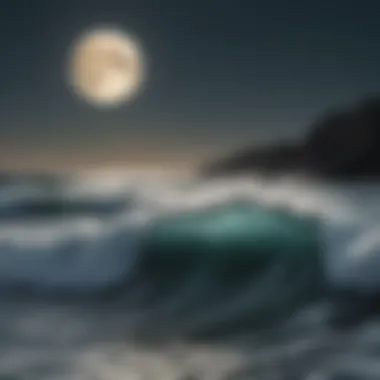
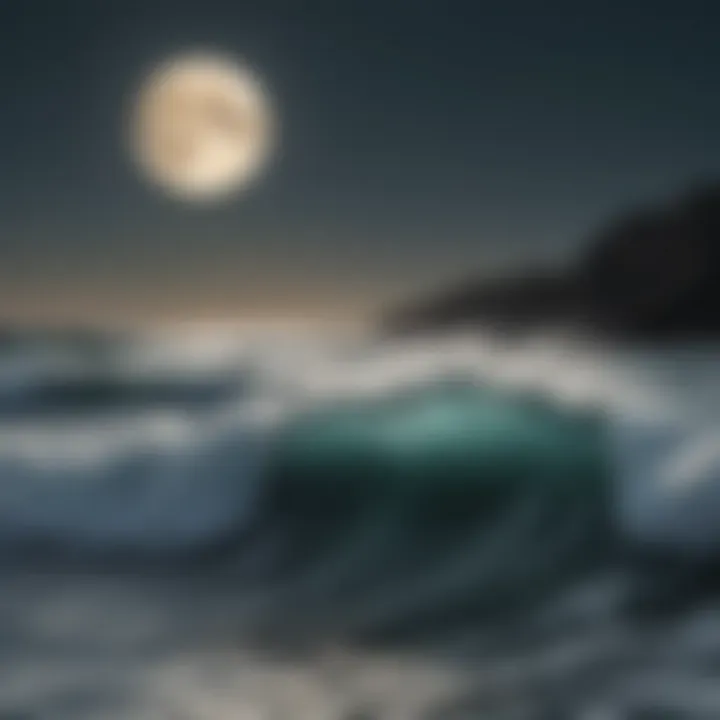
Impact on Wave Energy
The impact of pollution on wave energy is another significant theme. Pollution can change water density and thermal properties, affecting how waves build and break. For instance, oil spills can create slick surfaces that alter wave travel and generation—this can result in weaker waves overall.
The key characteristic here is how such changes can severely impact watersport activities, making conditions less predictable and potentially hazardous. It’s crucial for surfers and sailors to recognize that beyond visible particles, even invisible changes can affect wave behavior.
The unique feature of pollution's impact on wave energy is its complex interaction with weather patterns and overall ocean dynamics, making some areas more susceptible to extreme weather events. While there may be advantages in terms of economic development from industries that contribute to pollution, the disadvantages must be highlighted to raise awareness of the sacred relationship between humans and the ocean.
Understanding human activity and its effects on the ocean is not just important for scientific reasons, but it's essential for the livelihood and enjoyment of watersports enthusiasts. Sustainable practices must be at the forefront of discussions about coastal management.
Understanding Wave Predictions
Understanding wave predictions is crucial for anyone who spends time in or near the ocean. These predictions aid in anticipating wave patterns, which directly influences safety and enjoyment for various activities, particularly watersports. Accurate wave forecasting can transform a day of surfing or sailing into either an exhilarating experience or a risky venture. It brings you closer to understanding when and where the most favorable conditions arise, without leaving things to chance.
Wave Forecasting Models
The backbone of wave prediction is rooted in various forecasting models that help translate complex oceanic behaviors into understandable data. These models can broadly be categorized into two main approaches: numerical weather predictions and statistical approaches.
Numerical Weather Predictions
Numerical weather predictions utilize mathematical models to simulate the atmosphere. These models take various initial conditions—like wind speed, temperature, and air pressure—and process them through a series of algorithms to predict future weather patterns.
The key characteristic of numerical weather predictions lies in their elaborate computational methods. They can provide real-time updates that account for sudden changes in weather, which is a game-changer for wave forecasting. Its ability to integrate vast amounts of data makes it a valuable resource for this article.
One unique feature of these models is their temporal resolution. They can predict wave heights and patterns with a significant degree of accuracy over short periods. This means not just knowing that a storm is brewing days in advance but understanding how that storm will affect wave activity in the short term.
However, there are disadvantages as well. These models can sometimes lack sufficient resolution over smaller areas, potentially overlooking localized wave phenomena.
Statistical Approaches
On the other hand, statistical approaches analyze historical data to forecast future wave conditions. By examining past wave patterns and their relationships with climatic factors, these methods attempt to draw connections and provide insights into expected future behavior.
Their main advantage is the long-term reliability they offer. Statistical methods shine when it comes to trends over extended periods, allowing forecasts that cover several months or even years. This is particularly advantageous for surfers and sailors who prefer to plan their activities well in advance.
However, a crucial detail about statistical approaches is their dependency on historical data, which means they might not always account for sudden changes in climate or unusual weather events. This limitation can lead to inaccuracies during unprecedented conditions
Practical Applications in Watersports
Practical applications of wave predictions resonate most significantly among watersports enthusiasts. Knowing what to expect can spell the difference between an amazing ride and an accident waiting to happen.
Surfing Conditions
Surfing conditions depend heavily on wave size, frequency, and direction. Accurate wave forecasts help surfers select the best spots at the best times, ensuring a thrilling experience while minimizing risks. The ability to gauge when swells will crash against reefs or beaches is not only a convenience but a vital factor for safety.
Surf forecasts often highlight specific features like swells and conditions, providing surfers with essential information. This information fosters better decision-making. For example, a good forecast could indicate that a particular beach will have pristine conditions in the morning due to offshore winds, allowing surfers to ride the waves at their finest.
However, the unpredictability of nature means that even the best forecasts can sometimes miss the mark, leading to disappointment.
Sailing and Safety
In sailing, understanding wave conditions directly relates to safety. Accurate predictions ensure that navigators can make informed decisions about when to set sail or when to heed caution. Particularly when engaging in offshore journeys, having a reliable wave forecast can prevent dangerous situations on the water.
The key characteristic of sailing forecasts highlights the impact of wave height and frequency for determining optimal sailing conditions. Sailboats generally perform better in moderate conditions but can struggle in high waves. Thus, having an accurate forecast can direct sailors toward calmer waters.
Nevertheless, as with any prediction, there is an element of risk. Sailors must always remain vigilant and understand that conditions can change rapidly, thus maintaining a responsible approach for safety.
"In the world of watersports, knowledge is as essential as skill. Understanding wave predictions allows enthusiasts to make informed choices, ensuring both safety and enjoyment."
Wave predictions serve not only as a guide but also as a cornerstone for enhancing the experience and safety of watersport activities. With a deeper understanding of these forecasting methods, athletes and adventurers can navigate the ocean more confidently.
End
In closing, grasping the intricacies of ocean waves is not just a tale of science but a journey into understanding our relationship with the vast blue. This article shines a light on how various elements contribute to the formation of waves, offering a multifaceted view that spans from natural phenomena to human impacts.
Summary of Key Points
First and foremost, we explored the role of wind, which acts as the initial architect of waves. The speed and direction of wind create different wave patterns, while geographical features and ocean floor topography refine these patterns into something unique to each shoreline. We also touched on the celestial influences, especially the moon, reminding us of how tides can significantly alter wave behavior. Moreover, we examined the broader impact of climate conditions, notably the seasonal changes and storm patterns that further shape wave formations.
Next, we considered how human activity plays a double-edged sword. Coastal development can reinforce shorelines but may also disrupt natural wave patterns, and pollution brings severe consequences for marine ecosystems, thereby affecting the waves indirectly. Lastly, understanding wave predictions is essential for safety in water sports, allowing enthusiasts to optimize their experiences based on wave activity.
Future Research Directions
Looking ahead, there remains a wealth of opportunities for further study. Research could focus on aspects such as:
- The impact of climate change and how rising sea temperatures may influence wave patterns.
- The effects of urbanization on coastal wave dynamics, aiming to develop sustainable practices for coastal development.
- Enhanced wave forecasting models, integrating artificial intelligence to improve accuracy and predictive capabilities.
- Examining oceanic wave energy as a sustainable resource, exploring its potential in the context of renewable energy solutions.
By delving into these areas, we can better understand and safeguard the intricate dynamics of ocean waves, ensuring they continue to inspire and challenge water sports enthusiasts and researchers alike.















